
Venereal Disease Treatment Menu: 1 2 3 4 5 6 7 8 9 10 11 12 13 14 Next>>
Venereal Diseases in the Golden Age of Piracy, Page 10
Treating VD During the GAoP: Second Stage (Confirmed Pox)
The second stage of venereal disease according to the Universal Source Theory was a Confirmed Pox. Military

Artist: William Hogarth
Prostitutes, From Four Times of the Day - Morning (1738)
surgeon Matthias Gottfried Purmann mentions a variety of potential causes: "Now, though some Persons have been infected with it, only by drinking after such as have been tainted; by lying in the same Bed, or as others affirm, by the power of Imagination, yet Whoring is the principal Cause, to which an over hasty stopping a Gonorrhæa does not a little contribute; for it hurles up the Disease in the Body, instead of expelling the Contagion."1 The last cause agrees with points made in the previous section where a confirmed pox was believed to occur because the venereal taint had been driven back into the body by improper treatment on the part of the surgeon or physician.
There are two other points of interest in Purmann's comment. The first is that he mentions several dubious causes such as sharing a glass with or lying in a bed slept in by another infected person, although the way he states it suggests he does not entirely believe these to be valid causes. The second is that he points to 'whoring' as a cause of the pox in a way that makes it sound as if the Clap (gonorrhea) was a separate disease from a Confirmed Pox (syphilis). However, as explained previously, the period medical men recognized that what they referred to as the symptom 'gonorrhea' (uncontrollable running from the urethra) didn't always occur in the first stage of the Universal Venereal Disease. He alludes to this later in his introduction to the disease:

Matthias Gottfried Purmann
I say this Venom consists of Acid and Acrid particles, which first possess the Glands of the Privities in Men and Women, and after Coation when the Pores are closed, intermixes with the Sanative [healing] Juices thereabouts, and in a few days, raises a Fermentation that Produces a Gohorrhæa. But if this Venom is not powerful enough to put the circulating Juices to a stand, and raise a Fermentation so soon [basically, to cause a gonorrhea], then it spreads further into the neighbouring parts, yea, through the whole Body, causing many ill Accidents, and at length a perfect Pox.2
This is interesting because it suggests that if the venereal taint isn't strong enough to cause a first stage gonorrhea, it will spread on its own and cause a Confirmed Pox without any action on the part of the surgeon. He further explains that once "the Juices are infected, the Blood, Lymphs and Seccum Nutritius [partially digested food] become Acid and Acrid, and growing thick, not only obstructs the Glands, Muscles and tender parts, but also corrupts the Nerves, Bones and Ligaments"3. What Purmann says in these explanations is actually not that far from the way modern doctors understand the disease to spread.
1 Matthias Gottfried Purmann, Churgia Curiosa, 1706, p. 193; 2 Purmann, p. 194; 3 Purmann, p. 193-4
Treating VD During the GAoP: Second Stage (Confirmed Pox) - Modern Stages
Before looking at how the second stage of the Universal Venereal

Photo: Etienne Carjat - French Siphologist Phillipe Ricord
Disease was understood by the doctors of the golden age of piracy, it is helpful to see how it is understood today. Syphilis is currently recognized as going through four stages: primary, secondary, latent and tertiary. Somewhat confusingly, the fourth stage is called the tertiary or third stage because it was given that name by French venereal disease specialist Philippe Ricord in his 1838 book Théorie sur la nature et le traite-ment de l'epididymite. The latency stage was added several decades later. Since the terminology had been established by Ricord and accepted by the medical community, it was not changed to accommodate this new stage and the 'latent stage' was simply sandwiched in between the secondary and tertiary stages.
Syphilis is caused by Treponema Palladium spirochetes, which are little corkscrew-like bacteria. They enter the body at the point of infection and begin reproducing by division. They travel throughout the body via the blood and the lymph, infecting the entire body within hours.1 Even "before the painless chancre appears on the sex organ, the concentration of spirochetes reaches ten million organisms per gram of human tissue. The body's immune system wages war, and
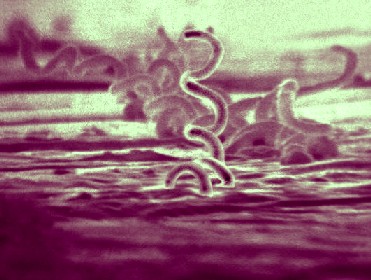
Image: CDC - Treponema Palladum Spirochetes
vast numbers of spirochetes die, but some remain clustered in tissues and periodically discharge showers of organisms from these reservoirs into the blood and lymph, thus starting lesions at numerous new sites."2
The modern primary stage of syphilis occurs when the chancre appears, usually at the site of infection. It is often a single, painless sore, although more than one sore will sometimes occur. Since it is painless, it often goes unnoticed by the patient. This sore typically lasts three to six weeks, going away on its own.3 This chancre is that same one identified by the period surgeons occurring in the first stage of the Universal Source Theory.
The modern secondary stage produces skin rashes and sores in the mouth and anus called mucous membrane lesions. This can happen either while the chancre is healing or several weeks after it has healed. The rash is faint, doesn't usually itch and appears as rough reddish or reddish brown spots on the palms of the hands or bottom of the feet. "Other symptoms you may have can include fever, swollen lymph glands, sore throat, patchy hair loss, headaches, weight loss, muscle aches, and fatigue (feeling very tired)."4 This stage can last from a couple weeks to six months and the symptoms will eventually cease even without treatment. "Early syphilitic infection imitates other fevers such as malaria, typhus, or typhoid."5
As early as 1495, Sicilian physician Nicolas Squillacio gave a remarkably accurate description of this second stage:
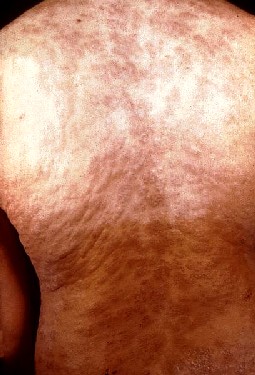
Image: CDC - Secondary Stage Syphilitic Rash
... there are itching sensations and an unpleasant pain in the joints; there is a rapidly-increasing fever; the skin is inflamed with revolting scabs, and is completely covered in swellings and tubercules which are initially of a livid red colour, and then become blacker. After a few days a sanguine humour oozes out; this is followed by excrescences which look like tiny sponges which have been squeezed dry; the sickness does not last more than a year, although the skin remains covered in scars which show the areas it affected. It most often begins with the private parts, before spreading to the whole of the body.6
However, for the most part, the medical men under study of the period do not mention this as a unique stage, simply lumping it in with other Confirmed Pox symptoms. Sea surgeon John Atkins comes as close to separating this out as any surgeon under study. He explains that if the medicines are not properly started and stopped when treating the first stage in the Universal Venereal Disease, the disease will turn inward and produce pain in the groin and swollen testicles (the 'rare' symptom of gonorrhea) "which may prove of as unhappy Consequence; particularly in the last the Pains are agonizing, and attended with Fever, Syncope [loss of consciousness] and Nausea."7
The next stage (actually the third of the four stages) is the modern latency stage, which produces no symptoms although the spirochetes are still present in the body.
, Ernest Besnier, 1895-7.jpg)
Sculptor: Ernest Besnier
Tertiary Syphilitic Gummas (1895-7)
The latent stage can last from as little as one year to as many as twenty.8 Syphilis is "very infectious for the first two years after infection, less so after that, and rarely after five"9, which helped further disguise its presence during the golden age of piracy. This absence of symptoms, combined with the lack of recognition of modern secondary stage symptoms by the Universal Venereal Disease, resulted in pox cases being declared cured after the treatment appeared to make the chancre disappear.
Of course, the idea of complete latency is something of a misnomer. During this stage, the patient becomes allergic to the syphilis bacteria and a slow progressing inflammation occurs whereever the spirochetes have taken refuge from the body's immune system, particularly the nerves and blood vessels. In addition, 20-30% of patients have relapses to second stage syphilis during the latent stage. In fact, syphilis is still contagious as long as second stage relapses occur.10
The modern tertiary or fourth stage of syphilis actually only occurs in 15-30% of the people with untreated syphilis.11 When it does strike, "[t]ertiary syphilis can affect multiple organ systems, including the brain, nerves, eyes, heart, blood vessels, liver, bones, and joints. Symptoms of tertiary syphilis vary depending on the organ system affected."12 This can occur as early as one year after contracting the disease and any time after that during the patient's lifetime.13 Although the organ-based symptoms vary widely, period authors did recognize third stage syphilitic gummas as part of the Confirmed Pox. These are destructive tumors that vary "in size from the microscopic to several centimeters in length. They may be found anywhere in the body, except the hair, the teeth, and the nails."14
Of gummas, historian Claude Quétel says, "At first they are hard, but they soften into a whitish and viscous substance (hence the term gumma); they ulcerate the body extensively, exposing the bones and eating away the nose, the lips, the palate, the larynx and the genitals."15
Deborah Hayden describes the third stage in this way:
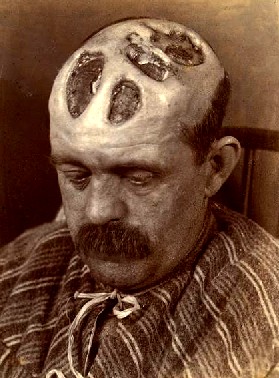
Tertiary Stage Syphilitic Ulceration of the Scalp,
St. Barts Hospital Archives, Wellcome Collection
Apparent good health alternates with bouts of being bedridden or hospitalized as pain flares up and subsides in one part of the body after another. Severe headaches with vomiting, gastrointestinal pain, and joint and muscle aches are typical, as are iritis, deafness, episodes of paralysis, and numerous other manifestations. Syphilis in this inflammatory stage sometimes mimics several syndromes simultaneously. The patient... often complains of feeling poisoned16
Quétel adds other symptoms which "include osseous [bone] lesions, deep and destructive ulceration [caused by gummas], the collapse of the nose, erosion of the nasal fossae [cavity] and the larynx, oedema [swelling of the body's tissues with fluid], the characteristics of consumption [tuberculosis] and cachexia [weakness and wasting away], etc."17
To confuse the 'stages' explanation even more, syphilis can actually affect the nervous and ocular systems at any stage of the disease. When syphilis infects the nervous system (neurosyphilis), it "causes a wide range of symptoms, including headache, altered behavior, difficulty coordinating muscle movements, paralysis, sensory deficits, and dementia."18 When it affects the eyes (ocular syphilis), it can result in "vision changes, decreased visual acuity, and permanent blindness."19 Such symptoms are sometimes mentioned by the period authors, although they are again lumped in with the Universal Source Theory's second stage - the Confirmed Pox.
1 Deborah Hayden, Pox, 2003, p. 43; 2 Hayden, p. 52; 3,4 "Sexually Transmitted Diseases (STDs): Syphilis - CDC Fact Sheet", www.cdc.gov, gathered 5/23/18; 5 Hayden, p. 54; 6 From a letter from Nicolas Squillacio to physician Ambroise Rosato, cited in Claude Quétel, History of Syphilis, 1990, p. 42; 7 John Atkins, Lues Venerea, not dated, p. 28; 8 "Stages of Syphilis", www.uofmhealth.org, gathered 5/23/18; 9 Hayden, p. 35; 10 "Stages of Syphilis", gathered 5/23/18; 11 "Syphilis: Symptoms and Causes", www.mayoclinic.org, gathered 5/23/18; 12 "Sexually Transmitted Diseases (STDs): Syphilis - CDC Fact Sheet (Detailed)", www. cdc.gov, gathered 5/23/18; 13 "Stages of Syphilis", gathered 5/23/18; 14 ,Hayden, p. 55; 15 Claude Quétel, History of Syphilis, 1990, p. 27; 16 ,Hayden, p. 55; 17 Quétel, p. 57; 18,19 "Syphilis - CDC Fact Sheet (Detailed)", gathered 5/23/18
Treating VD During the GAoP: Second Stage (Confirmed Pox) - Symptoms
As suggested, most of the symptoms found in the modern secondary and tertiary stages of syphilis as well as the effects on the nervous systems and the eyes are mentioned by the period sea and military doctors under study.
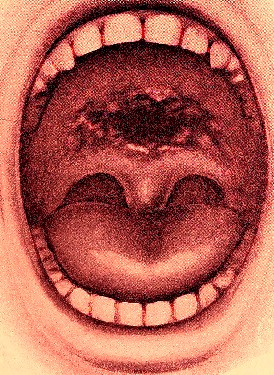
Syphilitic Mouth Ulcer, Exacerbated by Mercury, From
"Diseases of the Nose and Throat" (1903)
Sea surgeon John Moyle says that among the symptoms of a Confirmed Pox, "spots appear... Nodes are present; and phagadenick Ulcers are in the Mouth and Throat, and in divers parts of the Head and Body, with grievous Head-ach and night pains."1 In one of his case studies, Moyle explains that his patient exhibited "Nocturnal Pains and Nodes, and Ulcers in divers Parts of his Body, Limbs and Head, and what with this Torment, and the Medicinal Course he had undergon, the Man was become Macilent [thin] and Languid."2
Sea surgeon John Atkins says the symptoms of a Confirmed Pox include "cuticular Eruptions [rashes], Blotches, Ulcers in the Throat and Palate, Nocturnal Pains of the Head, Shoulders and Shins, Caries, Night-Sweats, Alopecia's [loss of hair], falling off of the Nails, Gummas, Nodes, Talpas [tumors on the head], Consumption and Marasmus [unhealthy weight loss]."3
German military surgeon Matthias Gottfried Purmann states that the symptoms of a Confirmed Pox include "running and spreading Tetters [red, irritated skin] and Blotches in several parts, the Scurvy, a sore Throat, perhaps Ulcerated; Ulcers and Nodes upon the Head, breakings out in the Face, and intolerable Itching and Heat in the Privities, which in time break out into filthy Ulcers."4 He later adds "a Pale Face, a Sallow Wan Complexion, great Pains in the Head, Aches in the Limbs, chiefly between the Shoulders, and along the Shin-bones, which are more apparent and troublesome in the Night than by Day"5. From these vivid descriptions, it can be seen that a Pox was typically confirmed by the appearance what are today recognized as secondary stage symptoms.
Some of the above accounts mention symptoms which could be associated with the third stage of syphilis such as gummas, ulcers (gummas are actually a type of ulcer), nodes and talpas, although the descriptions are not full enough to definitely conclude that these are tertiary and not secondary stage symptoms.
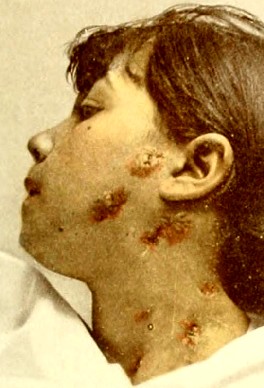
Secondary Stage Syphilitic Nodules, From
Photographic Atlas of the Diseases of the Skin,
By George Henry Fox (1905)
Historian Claude Quétel notes that once the secondary stage rash has taken hold, it is followed by the sorts of skin eruptions mentioned by the period authors. "In a few days the entire surface of the body is covered in small protuberant nodules, from which a fetid sanies exudes. Sometimes there were also thick scabs of a greenish-black hue which led contemporaries to report that the appearance of sufferers disfigured in this way was more repugnant than that of lepers."6 He goes on to note that this is followed by some of the other second stage symptoms such as weakness, lassitude and pain.
However, other parts of the golden age of piracy-era accounts clearly talk about gummas, typically considered part of the modern tertiary stage. William Cockburn associates gummas (which he calls 'Crystallins') with gonorrhea, although his book clearly confuses symptoms of syphilis with those of gonorrhea in several places. He explains that these are "little Pushes filled with Water, or Phlyctanæ, are Transparent, resemble Crystal; and, on that Account, are called Crystallins. …the Parts whereof, on which these Bladders do not appear, are very Red, and of a Blackish colour, as Parts are which have been Bruised."7
In one of his case studies, John Moyle mentions curing a man with a variety of skin conditions including "Siphilitic Ulcers in Throat and Tonsils, ... gummata on his Arms and Shoulders, & Nodes on Head and Legs, with other Serpiginous [skin scaling] breakings out on his Body."8 Unfortunately, he doesn't describe these conditions in detail, although most of them are fairly self-explanatory. John Atkins doesn't describe gummas, although he does describe what appear to be their effects on the body.
The Bones [in a pox] will waste sometimes, as well as the Flesh in this Distemper, a Collapsion of their Fibres one third in Diameter; and this from the defect and corroding Quality of their Nourishment. Or they will become Carious [decayed], especially the Skull and Shinbones, these in the manner of a Honey-comb almost; with little rough Spiculæ [sharp objects], that touching the Periosteum, Pericranium, or Dura Mater, produce exquisite Pain and Anguish.9
 of the leg, Jumelin.jpg)
Sculptor: Jumelin
Tertiary Syphilitic Gumma of the Leg
Sea surgeon Hugh Ryder mentions what appears to be a gumma while describing his treatment of other wounds received by "a Venereal Person." While he is somewhat more interested in describing the wounds of the arm and head the patient got during some sort of fight, he also notes that there was "an Ulcer on his right Leg, a little above the Meleolus externus of an ill Figure". It is not certain that this was a gumma, although he says that it and the other wounds produced "an ugly Ichor or Sanies, or sometimes a greenish sordid matter" which he blamed on the venereal disease.10
Atkins also mentions a condition not typically associated with syphilis which he calls spina ventosa. He explains that such a symptom "is now and then the Fruits of a pocky Consumption: Here the Bones do not pine but swell"11. This modern explanation of spina ventosa is caused by tuberculosis and usually observed in children. Atkins describes how this problem "by its Sharpness erodes through the Skin into little Ulcers."12 This actually makes a little more sense. Since Atkins does not make it clear how he knows the bones have swollen, it is possible that this may actually be due to syphilitic nodes or something similar that only appears to be spina ventosa.
For the most part, the period surgeons do not mention the other modern tertiary stage symptoms mentioned previously, probably because they didn't associate them with the venereal disease and problems. For example, Atkins mentions the syphilitic 'Fall of so many Noses', which refers to the loss of the nose caused by gummas, although he blames it on mercury.13 Indeed, mercury poisoning symptoms would have confused the understanding of syphilitic symptoms. Deborah Hayden points out, "How, for example, could a doctor distinguish the neurological damage of tertiary syphilis from the neurological damage of mercury poisoning? Or mercury paralysis from that of tabes [dorsalis - syphilitic damage to the spinal chord causing loss of coordination and movement]?"14
Syphilis' wide variety of symptoms were so similar to other health problems that English surgeon Sir Jonathan Hutchinson referred to syphilis as 'The Great Imitator' in a speech given to the British Medical Association in 1879. Hutchinson "listed disease states for which he had found a syphilitic double, encouraging doctors to look for a history of syphilis behind symptoms that would otherwise appear to be another disease. His list of examples included smallpox, measles, psoriasis, lupus vulgaris, iritis, and epilepsy."15 It wasn't until 1883 that French doctor Jean Alfred Fournier said that insanity and paralysis were other symptoms of this disease. So it is almost certain that surgeons during the golden age of piracy misdiagnosed symptoms of syphilis as being due to other diseases which were better understood at the time.
1 John Moyle, Chirugius Marinus: Or, The Sea Chirurgeon, 1693, p. 143; 2 John Moyle, Memoirs: Of many Extraordinary Cures, 1708, p. 86; 3 John Atkins, Lues Venerea, not dated, p. 36; 4 Matthias Gottfried Purmann, Churgia Curiosa, 1706, p. 193; 5 Purmann, p. 194; 6 Claude Quétel, History of Syphilis, 1990, p. 26-7; 7 William Cockburn, The Symptoms, Nature, Cause and Cure of a Gonorrhoea, 1713, p. 81-2; 8 Moyle, Memoirs, p. 96; 9 John Atkins, The Navy Surgeon, 1742, p. 239-40; 10 Hugh Ryder, New Practical Observations in Surgery Containing Divers Remarkable Cases and Cures, 1685, p. 13-4; 11,12 Atkins, Navy Surgeon, p. 240; 13 Atkins, Navy Surgeon, p. 252; 14 Deborah Hayden, Pox, 2003, p. 47; 15 Hayden, p. 33

